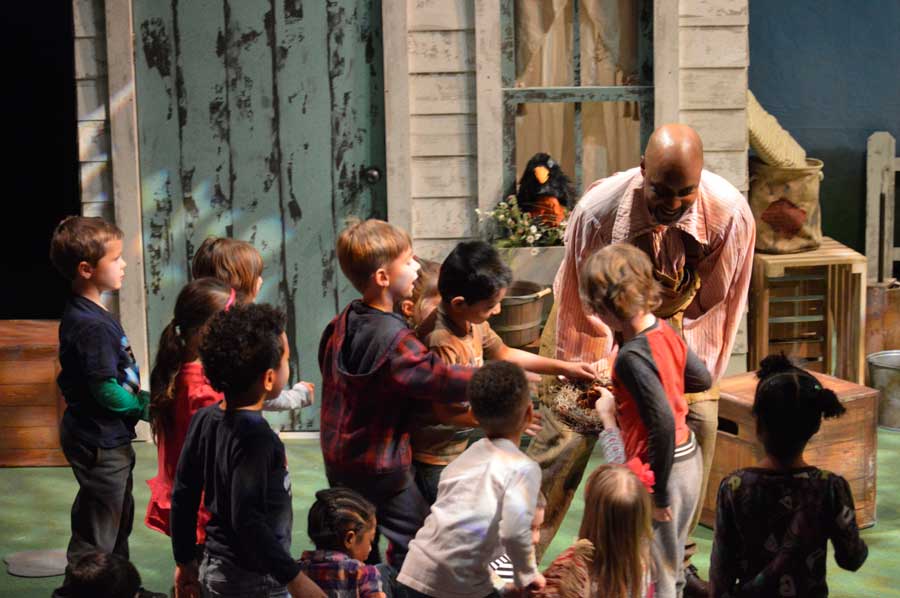The mother robin is hungry. She just watched all of the actors enjoy a slice of an apple. It was a big apple—a juicy apple—and it made this mother bird feel hungry. But she doesn’t want an apple. Birds don’t eat apples.
Then what should the mother robin eat?
“Does it eat bananas?” an actor onstage asks the audience. Lobster? Rubber boots?
“I know!” yells Danny, a 3-year-old standing in the garden. “A bird eats seeds! Seeds!” Danny is right. All of the actors pull seeds out of their satchels and feed the robin. The bird is happy.
Danny’s answer wasn’t rehearsed or planned; Danny didn’t have to memorize lines or go to any rehearsals. But Danny, along with the 28 other preschool students in the audience, played an integral role at one of 26 January performances of Barry Kornhauser’s 45-minute A Child’s Garden of Verses, a play tailored to youngsters age 2 to 6 years old, at Nebraska’s Omaha Theater Company, known locally as the Rose Theater.
Danny could play such a role because A Child’s Garden is built to incorporate the unscripted actions of its preschool audiences; how they answer questions, and the level at which they participate, is an important part of keeping the show moving. This high level of audience participation and engagement is one of the many elements central to this production, one of a growing genre called Theatre for the Very Young (TVY), itself a subset of Theatre for Young Audiences (TYA). Interactive and immersive approaches may be increasingly common at all age levels, but they’re practically a given with TVY work.
“What’s so important about this is that the audience members are able to experience the play, not just viewing it from the outside, but inside the play,” said director Stephanie Jacobson, a teaching artist and resident director of youth productions at the Rose. “We’re constantly thinking about how to build those special moments and include the young cast members.”
Even for a genre that’s known for being interactive, Kornhauser’s A Child’s Garden of Verses, a “celebration of both childhood and play,” is especially so. Based on and employing selections from Robert Louis Stevenson’s 1885 collection of the same name, the play takes place in a whimsical English garden of the late 19th century, through which four characters—Actor #1/Tom, Actor #2/Gardener, Actor #3/Bird, and Actor #4/Musician—take children on a multisensory adventure. Throughout the play, actors invite the children to explore the garden, encouraging them to frolic in the leaves, feed a bird, build a boat, and dance with the wind. Familiar children’s music—performed in this case on violin, mandolin, and guitar by Caulene Hudson—enhances the beauty of the verse and also provides sound effects as needed. And to get the young audience to participate in the show’s various adventures, the script includes several questions, cues, and invitations designed to make them veritable members of the cast.
In the midst of all the adventures, an overarching storyline develops, involving a lonely gardener making new friends. The curmudgeonly gardener, played by Tyrone Beasley in the Rose production, plants and tends his garden but “never seems to want to play.” Instead he comes out of his shed, plants seeds, goes back into the shed, and repeats throughout—until another character, Tom, invites him to jump into a pile of leaves. “Well, who’d have thought!” Tom says when the gardener accepts his invitation. “You never seemed to want to play.” The gardener responds: “I never had any friends to play with.”
The 15 Stevenson poems sprinkled throughout the play center on the theme of growth and serve as introductions to the show’s sections (“We built a ship upon the stairs / All made of the back-bedroom chairs / And filled it full of sofa pillows / To go a-sailing on the billows”), informing actions and supporting the overarching story.
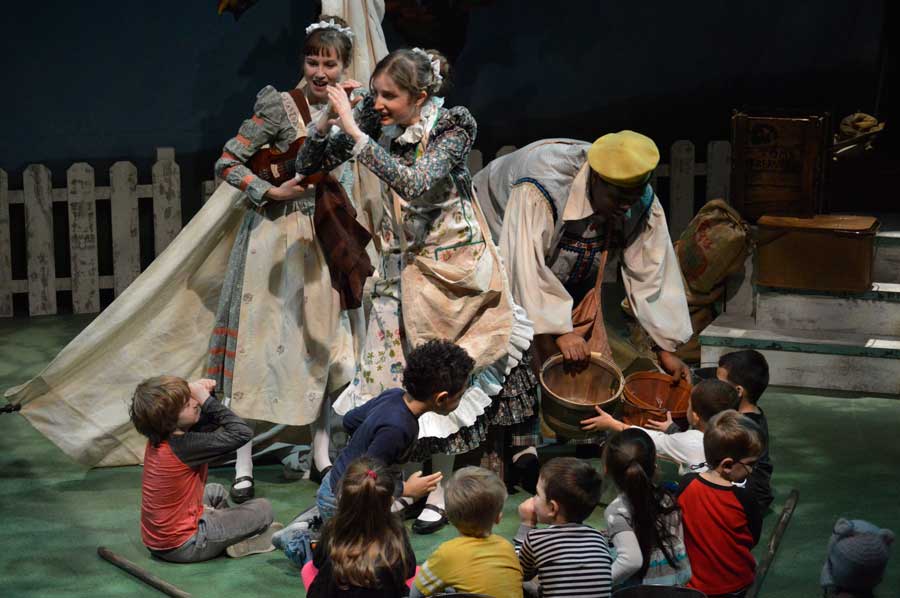
With its poetic undertones, interactive plot, and musical accompaniment, A Child’s Garden has an experimental feel, and that may be because it was the first play veteran playwright Kornhauser wrote in the TVY genre. Kornhauser, who has since written two more pieces in this vein (Balloonacy and Bert & Ernie, Goodnight!), said that theatre for children this young must not be designed with the expectation that they’ll be stationary observers but rather active co-players.
“A Theatre for the Very Young piece should be constructed with an understanding that its audience will not be sitting still—or quietly—for its duration,” Kornhauser said. “In fact, that is one of TVY’s gifts to parents and caregivers, that their children are not expected to be ‘proper,’ polite, well-behaved audience members, but rather active, even boisterous participants in the goings-on.” And this is more than simply fun and games, he added: “When that audience is made to feel safe and secure in playing along, the play also becomes a mechanism for creating a sense of belonging and of engagement with a communal experience—features critical to early development.”
Rosemary Newcott, the Sally G. Tomlinson artistic director of Theatre for Youth and Families at the Alliance Theatre in Atlanta, originally approached Kornhauser about writing the piece for the Alliance.
“She asked me if I was interested in doing a play based on poems by Robert Louis Stevenson,” said Kornhauser, who currently works for the Office of Visual and Performing Arts at Millersville University in Lancaster, Pa. Newcott told Kornhauser she thought Stevenson’s poems had a “charming, cross-generational appeal.” In addition, the idea of “colliding” with classic texts to create artful new performances is a focus of student and professional work at the Alliance. Kornhauser, who’s written more than 30 plays over the course of his career, was intrigued, not only by the idea of working with Stevenson’s poems, but also by the challenge of writing for such a young age group.
“One reason preschoolers are such a good audience has a lot do with the fact that they are innocent of what to expect in a play,” Kornhauser said. “So as an artist, you can be very free, unbound by the confines of those learned intellectualizations, and open to new and playful dramaturgical explorations. They will embrace your work with openness, energy, enthusiasm, and joy.”
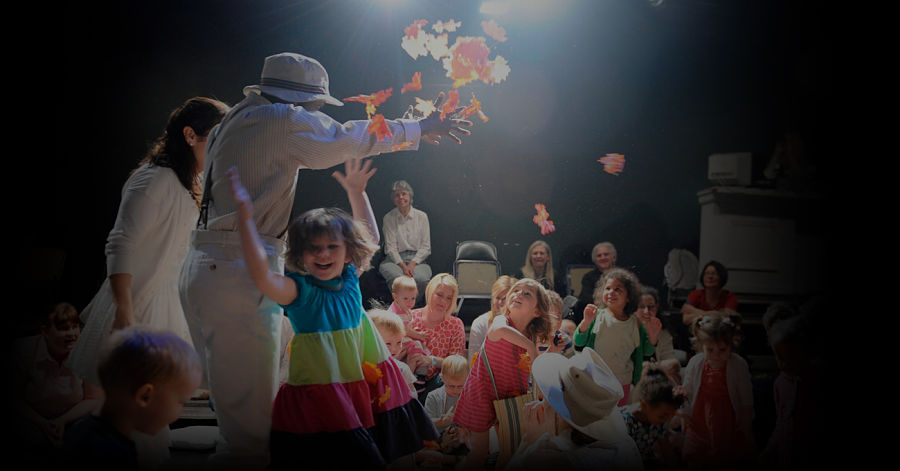
Do you think in half an hour
A seed can grow into a flower?
A fragile flower just like this
that the breezes like to kiss?
A Child’s Garden of Verses premiered in 2011 at the Alliance. When the Rose decided to increase the number of plays it programs for very young audiences from one to two during its 2015–16 season, Kornhauser’s garden romp was a natural choice.
“I liked how it used poetry and delivered it through a narrative vessel to an audience this young,” explained Rose artistic director Matt Gutschick. The theatre, one of the largest children’s theatres in the nation, providing professional productions and arts education programs to thousands of children in the Omaha area annually, had a prior relationship with Kornhauser, having produced his Balloonacy during the 2013–14 season and again during the 2014–15 season.
While Jacobson hadn’t ever directed a piece for the very young, she had extensive experience with this age group. Before taking a position as a teaching artist and director of youth productions at the Rose, she worked on the set of “Sesame Street” in New York City, and over the past several years has taught several acting and musical theatre classes for preschoolers.
It’s an age group, Jacobson, said, that “is so inquisitive about all of the new reveals. They want to see it, feel it, get really close. They don’t want to just sit and watch us play, or see how we deal with something—they want to come and play with us.”
With Jacobson leading the charge, work on the production began in October of 2015 with design meetings. Kornhauser’s script conveyed that the set should look like a “whimsical English garden, with a number of things one would expect to find there.” And while the script was specific about some items—like the inclusion of a small, flat wooden wagon, an apple tree, and a picnic basket—much else was left to interpretation.
One thing that was unique to the Rose’s production was that it would be staged in the Hitchcock Theatre, a 130-seat space used for smaller productions, workshops, and class performances. While other productions of A Child’s Garden of Verses have been designed to be portable so they could travel to community spaces and schools, the Rose’s production would stay at the Hitchcock.
Knowing the production wasn’t mobile, scenic designer Ronnie Wells decided to create a life-size garden shed, instead of just a free-standing window, as the script suggests, and put it stage right; it was a space the actors could enter, exit, and store props in throughout the production. This also made it possible for all of the actors to stay in the room during the entire performance.
Another more permanent element Wells created was an elevated platform on stage left where the musician could both perform and safely store her violin, guitar, and mandolin during the play. Jacobson said the platform “looked like part of the set, but it was not a place the children could easily go.”
With the set design in progress, actors began working on their lines. The four cast members, all of whom were contract artists or staff members at the Rose, were chosen for their experience as educators as well as their experience acting in productions for youth.
“We wanted actors who were true ensemble players,” Jacobson said. “It’s really about the group and the audience’s experience. It was important for these actors to know what the story was and what their relationship to the other characters was, but it was even more important that they knew how to invite the audience, welcoming them as fellow actors and saying ‘yes’ to their ideas.”
Formal rehearsals began in early December, a little more than a month before the play opened. The cast had five days of rehearsals before the holidays, then came back in early January for a week of technical rehearsals and audience previews.
As the production began to take shape, a series of challenges, unique to the play as well as to the TVY genre, surfaced. How could the production ensure visual clarity for the different-sized audiences, which would range from 10 to 120 people, as well as all of the different ages, which would range from 6 months to 8 years? (Despite the 2–6 age advisory, the Rose knew to expect outliers on either end.) What were some of the ways the cast could interact with the audience members throughout the play, so each child felt like they could participate as a cast member? Finally, considering all of the interactive elements and some potentially large houses, how could they ensure the set was safe for the young participants?
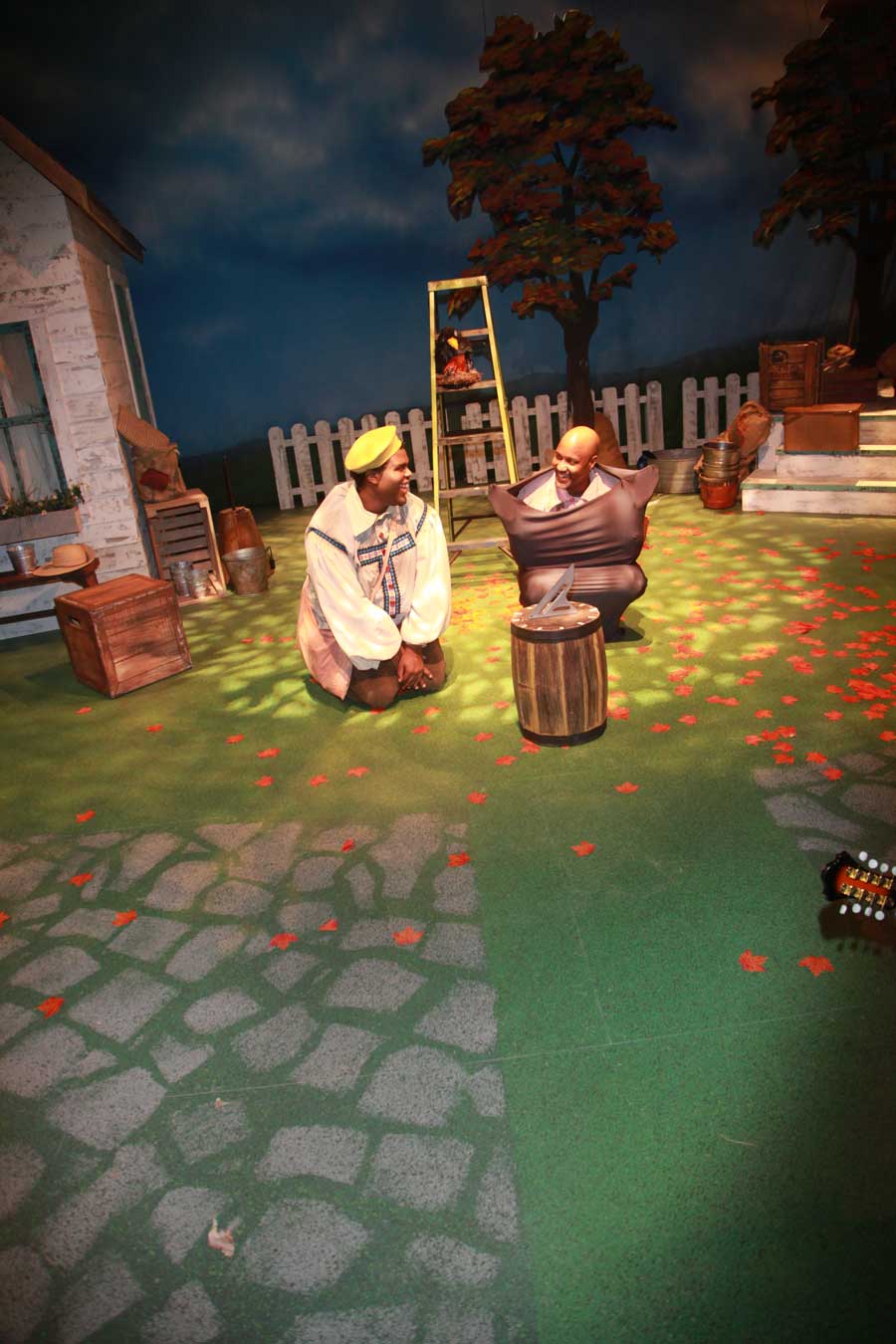
Clarity was the first big issue for Jacobson. She went into the process knowing the play didn’t necessarily have a traditional structure. The poetry and interactive elements gave it a more free-form feel, and some of the actors had two-track roles that involved playing both human characters and puppets. This would be easier to pull off with a smaller audience—Kornhauser’s script says the piece is intended for a group of 20–30 participants, including caregivers. But for a theatre with a theatregoing base as large as the Rose’s, that number proved impractical. While many of the public performances stayed in the suggested range, larger school groups frequently numbered more than 100.
“[Theatre for the Very Young] is a new thing for us and a new kind of thing for Omaha,” Gutschick said. “In order to be able to support this kind of theatre, we need to be able to have those kinds of [large] houses.”
Jacobson searched the script for ways to simplify and streamline the themes, to make sure the throughline between Tom and the Gardener was as clear as it could be in a bigger room. For example, the script calls for Actor #2 to play the role of the Gardener as a puppet, as well as portraying an additional friend in the garden. But for the sake of clarity, Jacobson had Beasley play the Gardener as his human self, and the lines given to the additional friend associated with Actor #2 were read by other actors already identified as friends in the garden.
The next challenge was to figure out how to not only keep the audience’s interest throughout the entire play, but also make them feel comfortable and engaged enough to want to interact with the actors. A Child’s Garden of Verses is full of opportunities for such interactions. Kids are asked to join the musician on a sailboat, to give the mother robin seeds, to join the actors for a picnic, to jump in a pile of leaves, to pop bubbles, to dance with eggs, to plant words and seeds, even to use sign language.
Finding these opportunities wasn’t a problem—they’re written into the script. Rehearsing them and anticipating how kids would react to them without those kids in the rehearsal room was a bit of a challenge.
“We went through our rehearsal process knowing there was going to be a lot of audience participation and engagement,” said Hudson. “Trying to imitate that in the rehearsal hall was very difficult. It was almost like we were trying to rehearse the piece without the main character.”
A couple of preview performances with preschool children brought some issues to light. For example, at one point in the show, Tom pours a bucket of leaves on the floor. The original plan was for Tom to jump in the leaves, then invite the Gardener to jump in them too, then invite the kids to join in. But as soon as Tom dumped the leaves on the floor during a preview show, a number of kids ran up to the stage and began romping on them. “We were surprised by the large number of audience members storming the stage,” recalled Nik Whitcomb, who played Tom.
So Jacobson introduced a cue in that section to help manage the jumping. As Tom poured the leaves, he signaled to the audience to count with him “1-2-3,” and only then to join him onstage for some leaf-crunching.
A related challenge was safety. In traditional productions where the stage is elevated and the audience is more passive, artistic and production teams don’t need to consider all of the potential hazards or accidents that might befall their audience. Knowing the age and potential size of the audiences for A Child’s Garden of Verses required the artistic and production teams to essentially child-proof the set.
Flowers are nice, for instance; leaves with prickly ends or thorns are not. Bubbles are fun, but too many bubbles would mean a slippery floor. And that scene where Tom throws all of the leaves up in the air? That would work as long as there weren’t too many leaves and too many kids jumping in them; the more kids and leaves they had, the greater the risk of accidental tripping and falling. Also, with so many props going on and off the stage, the actors needed to constantly be aware of what items might be obstructive or potentially harmful, such as a wagon someone could fall on, an umbrella that could poke someone, or baskets of treasures a child might trip over.
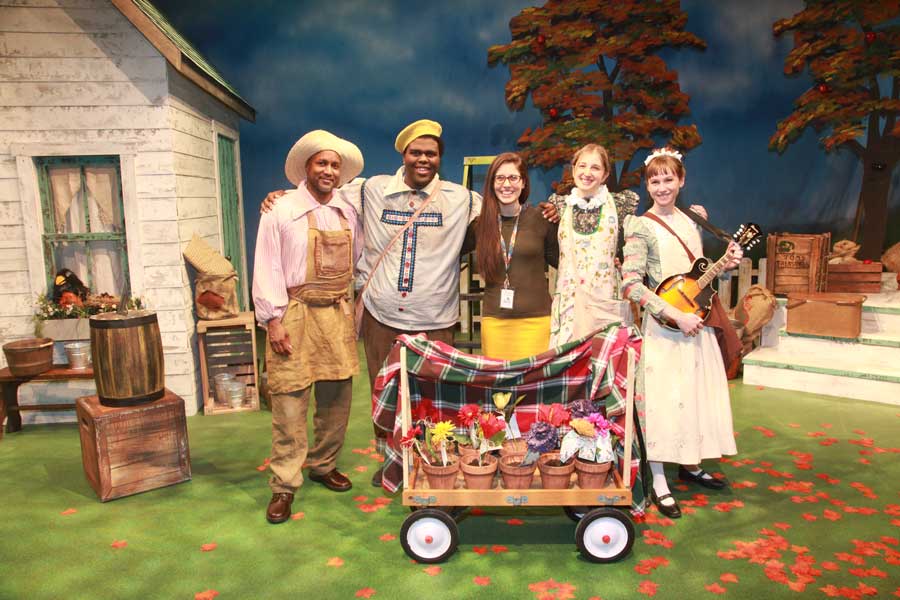
After 26 performances and interactions with the nearly 1,200 young audience members who attended, Jacobson and the other cast members say the extra effort required to mount A Child’s Garden of Verses for the Rose was absolutely worth it. For one thing, many of the artists involved learned new skills or had experiences they said will help them in future productions.
Jacobson said her work on the production has greatly informed her creative process for a new play for the very young she is writing, Thumbelina, which will be part of the Rose’s 2016–17 season. Hudson, the musician, had to learn to play the mandolin for the show, a skill which will be an asset in the future. And Whitcomb said that being in a performance situation where he constantly had to adapt and adjust to the needs of each new audience was a great exercise for him as an actor.
“From an artistic standpoint, this age group stretches our performers and designers and directors to think in participatory and often non-narrative terms,” Gutschick said. “That ends up embodying a beautiful marriage between our social purpose and our artistic rigor.”
Hudson said her favorite thing about the show was the way children reacted to the ending. At the beginning of the show, a few children from the audience would help the actors plant seeds for the flowers to grow at the beginning, and throughout the show, the actors would check to see if anything had grown. Again and again they were disappointed—until the very end, when the actors revealed that the flowers had finally sprouted and grown.
“Everyone of all ages is shocked there are flowers there,” Hudson recalled. “It’s very rare that the magic is as effective as it is in that one specific moment.”
Or there was the time a little boy told Whitcomb, “I don’t play” at the beginning of the show, and indignantly watched the beginning from outside the theatre, peeking around the corner. Finally, though, the youngster gave in and wanted to be a part of it. “That was a really special moment for me,” Whitcomb said. “After the show I told him, ‘Thank you for playing with us.’”
It is this kind of personal attention from the artists that made A Child’s Garden of
Verses so memorable, according to Gutschick. “I think the actor’s performances made this approachable, understandable, and engaging,” he said. “I think that was the largest challenge, but the group Stephanie guided was good at making this approachable.”
Not everything about the experience was sunshine and butterflies. Jacobson said that if she could do it again, she’d have tried an in-the-round setup so the kids could come up to participate without having to travel too far. And she admitted she would have preferred more preview performances so the team could have had more opportunities to gauge how the kids might react (or not) to different scenes.
Despite the audience hiccups and unseen challenges, the Rose plans to continue offering TVY productions twice a year. “We believe it is essential to engage very young children, because this is the age when some of the greatest neurological and cognitive gains from experiencing live theatre can be realized,” Gutschick said.
The play wasn’t reviewed by local media, but responses from parent surveys indicate that the community would welcome more work like this. Wrote one mom, “My little one LOVED it. We are now signing up for acting classes because of it.” Another wrote: “We were so impressed and pleased, and hope you have similar performances in the future!”
The impact of such a show may be hard to measure, especially among those that are so young. But if children walked away with an experience that might make them more likely to come back to the theatre—mission accomplished.
“The words that are said in the show, they might not get them right now,” Hudson said. “But if you plant the seed, it’s going to continue to grow.”
Ashley Wegner is a freelance writer and editor based in Omaha, Neb.

